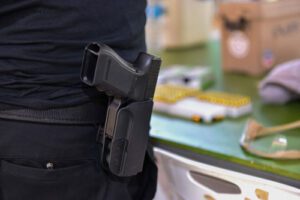 The Court continued: The Second Amendment ‘is the very product of an interest balancing by the people’ and it ‘surely elevates above all other interests the right of law- abiding responsible citizens to use arms’ for self-defense . . . It Is this balance—struck by the traditions of the American people—that demands our unqualified deference. Id.
The Court continued: The Second Amendment ‘is the very product of an interest balancing by the people’ and it ‘surely elevates above all other interests the right of law- abiding responsible citizens to use arms’ for self-defense . . . It Is this balance—struck by the traditions of the American people—that demands our unqualified deference. Id.
The Bruen Court then applied the test set forth in Heller to the challenged legislation, further instructing District Courts considering Second Amendment challenges “to assess whether modern firearms regulations are consistent with the Second Amendment’s text and historical understanding.” Id. at 2131. The Bruen Court gave important examples indicating how District Courts might detect unconstitutional legislative overreach in Second Amendment terms: [i]n some cases, that inquiry will be fairly straightforward. For instance, when a challenged regulation addresses a general societal problem that has persisted since the 18th century, the lack of a distinctly similar historical regulation addressing that problem is relevant evidence that the challenged regulation is inconsistent with the Second Amendment. Likewise, if earlier generations addressed the societal problem, but did so through materially different means, that also could be evidence that a modern regulation is unconstitutional.
And if some jurisdictions actually attempted to enact analogous regulations during this timeframe, but those proposals were rejected on constitutional grounds, that rejection surely would provide some probative evidence of unconstitutionality. Id. By contrast, in “other cases implicating unprecedented societal concerns or dramatic technological changes,” historical analogies will not be as easy to draw and “may require a more nuanced approach.” Id. at 2132. Nevertheless, “the Constitution can, and must, apply to circumstances beyond those the Founders specifically anticipated.” Id. (citing United States v. Jones, 565 U.S. 400, 404–05 (2012)). Thus, in keeping with Heller, District Courts must look to historical context because “it has always been understood that the Second Amendment . . . codified a pre-existing right.” Id. at 2127 (quoting Heller, 554 U.S. at 592) (emphasis in original).
When phrased in terms of a law-abiding citizen’s right to self-defense, it is difficult to argue with the Court’s logic. The alternative is to accept a scenario wherein: a lawful gun owner is threatened with an unlawfully possessed gun outside of his home, he uses justifiable deadly force to defend himself, and is still guilty of an unlawful possession of a firearm offense that carries mandatory years in prison with parole ineligibility.
